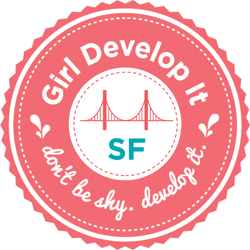
Intro to WordPress
About You
Why do you want to learn WordPress?
- Your name and background
- Anything in particular you are hoping to learn today?
Objectives
To become familiar with the WordPress dashboard, plugins, themes, widgets and more!
Ask Questions!
Using your own WordPress install today?
Are you able to add posts and pages and change the theme and navigation to your site?What we'll cover today
- What WordPress is
- How to build out a site with pages and posts
- Plugins - how to find, install, and activate them
- Widgets and Menus
- Themes - how to find, install, preview, and activate them
- Customizing themes
- How to keep your site secure
- More advanced installs
- Administrative backend functionality
- Resources, questions, and if there's time, some one-on-one help
But first...
let's learn how the web works!
What is WordPress?
Official description from WordPress.org
WordPress is web software you can use to create a beautiful website or blog. We like to say that WordPress is both free and priceless at the same time.
WordPress is Popular
26.4% of all the websites use WordPress.
WordPress is the #1 content management system in the world (59.4% marketshare).
WordPress is
Free, open source, web-based software
WordPress core software is built by hundreds of community volunteers. People all around the word contribute to WordPress by either submitting bugfixes, testing, designing or writing code for the software.
WordPress is
A content management system
WordPress allows site owners to manage their site content via an easy-to-use admin dashboard.
WordPress.org vs. WordPress.com
- WordPress.org - Web software used to build a website on a hosting account with a domain name. Sites can be built and modified using themes, plugins or custom code
- WordPress.com - A free blogging service that allows people to create a blog hosted on WordPress.com's servers. Hosting is free (although there are some for-pay add-ons), theme choices are limited, plugins can not be installed and code can not be modified

Hosting a Wordpress Install
-
If you're selling to clients, we recommend a "managed" wordpress install
- Pros: Hassle-free. This includes security, speed, WordPress updates, daily backups, website uptime, and scalability. WPEngine is top-notch, GoDaddy also has this option.
- Cons: More expensive (starts at $30/month, often limits you to wordpress only
- For a simple blog, we recommend shared wordpress hosting (what we're using today)
- More about managed wordpress hosting
- More about shared hosting
Exercise: Get logged into WP Admin
A Tour of the Front End
WordPress comes with the default theme Twenty Seventeen activated
- A sample post on the home page.
- A sample page
- A sample comment
- A sample tag line "Just another WordPress site"
- A set of sidebar widgets
A Tour of the Backend Admin
Located at: yourdomain.com/wp-admin/
The admin is divided into 3 areas:
- The top menu bar
- The left-hand menu used to navigate to most admin functionality
- The main content window where most admin functionality is performed
A Tour of the Backend Admin
Located at: yourdomain.com/wp-admin/
Tip: You can change what's displayed on an admin page by clicking on the "screen options" tab in the upper right corner.
Another Tip: Open the front end of your site in one browser tab and the backend in another so you can easily switch between the two as you make changes to your site.
Pages and Posts
- Pages: Regular static website pages with content
- Posts: Entries (like blog posts) that have a date, categories and tags assigned to them. They can be listed in a particular order (chronologically, alphabetically, etc.) and fed to other sites or blog readers via an RSS feed

Pages and Posts
Let's look at some examples!
Pages
- Page Title
- Permalink: Manage the name of the page URL
- Revisions: View and restore previous versions of the page
- Discussion: Turn comments on or off for this page
- Comments: Displays current page comments
- Slug: Manage the name of the page slug
- Author: Switch between post authors (display requires theme support)
Using the Content Editor
- Visual and Text tabs: Toggle between WYSIWYG and code view
- Add Media: Upload pictures and other files
- Button Bar: Use formatting and display options
- Embeds: Paste links to popular media services and they will automatically display on the page
Posts
- Excerpt: Use the Read More button (display requires theme support)
- Categories and Tags: Assign categories and tags to allow posts to be organized by subject
Tip
Use the bulk editor on the page or post list to make edits to multiple pages or posts at a time (like removing comments).
Exercise Time!
Create pages and posts for your site.
- Add placeholder text using Lorem Ipsum: www.lipsum.com
- Add an image
- Make a page password-protected
- Make a page a "child" of another page
- Embed a YouTube video or audio playlist
- Add a link
- Change the permalink of a page
- Create a bullet point list
- Create a new category and assign it to a post
Setting Up Your Site
The Settings menu
- General: Title, tagline, site address, date format, etc.
- Writing: Post-related settings
- Reading: Set site home page, # of posts, rss settings and search engine visibility
- Discussion: Manage comment settings
- Media: Make default image sizes and other media settings
- Permalinks: Define the structure of site URLs
Exercise Time!
- Change the name of your site
- Change the "Front page" of your site to the sample page
- Create a page called "blog" and set as your "Posts page"
- Require comments to be approved by an administrator before they are posted
- Set your timezone to "Los Angeles"
- Change the permalink set-up to "Post Name"
- Remove the "WordPress News" from the dashboard
Changing Site Appearance
The Appearance menu
- Themes: Manage the current theme in use and other installed themes
- Widgets: You can add content to your site sidebars or other "widgetized" areas using widgets
- Menus: Manage Custom menus
- Header: Manage header text and image
- Background: Manage background color and image
- Editor: Dangerous way to edit theme and plugin flies. This is disabled if you "harden" WordPress
Managing Menus
Appearance > Menus
Easily create and manage navigation menus
- Create menus: Enter a menu name and click "Create Menu"
- Add pages: Add existing pages, custom links or category pages
- Order Pages: Drag and drop your pages menu items in the desired order. Indent pages to make them children of other pages
- Assign Menu to Theme location: When the menu is ready, assign it to a theme location and click "Save Menu."
- Manage Locations Tab: Assign menus to theme locations
Exercise Time!
- Remove a few widgets and add some of your own text to the sidebar using a text widget
- add a link in the text widget using my super handy trick for those who don't know HTML
- Add a picture to your header
- Change the color of your header text
- Change the color of your background
- Have one menu item link to google.com
- Create a dropdown Menu
- Have one menu item link to a category
Managing Comments
The Comments menu
View, approve, delete and mark comments as spam.
Managing Media
The Media menu
View all files that have been uploaded to the site via the content editor. Add, edit and delete files.
Managing Users
The Users menu
- Manage existing users: Edit all user data or delete users
- Removing an admin user (do this if the username is "admin")
- Add new users: Assign new users to site
- Your Profile: Edit your own profile settings
Managing Users
User roles
Users can be given certain levels of editing privileges.
- Administrator: access to all the administration features within a single site
- Editor: ability to publish and manage posts including the posts of other users
- Author: ability to publish and manage their own posts
- Contributor: ability to write and manage their own posts but cannot publish them
- Subscriber: ability to only manage their profile
10 minute break!
What are Plugins?
Official description from WordPress.org
Plugins can extend WordPress to do almost anything you can imagine.
Plugins are Powerful
Plugins are used to add functionality to WordPress. Examples include ecommerce, SEO, forms, photo galleries, social media sharing, forums and much more!
Plugins are Often Free
Right now there are over 43,850 free plugins in the official WordPress Plugin Directory.
Managing Plugins
WordPress comes with 2 plugins:
- Akismet: Protects your blog from comment and trackback spam. This plugin requires an Akismet key
- Hello Dolly: Adds a random lyric from "Hello Dolly" to the upper right-hand corner of admin screen.
Managing Plugins
- Activate/Deactivate: Turns plugins "on" and "off"
- Edit: Ability to edit plugin files NOT RECOMMENDED
- Delete: Delete deactivated plugins
Finding Plugins
- Searching under Plugins > Add New
- Browsing the WordPress Plugin Directory
3 Ways to Install Plugins
- Clicking "Install Now" from "Install Plugins" search results
- Download a plugin zip file and install it via the "Upload" link
- Unzip the plugin files and upload it via FTP to the
/wp-content/pluginsfolder
Plugin Shortcodes
Plugins often use shortcodes to add content to a page or post.
For example, the plugin
Contact Form 7 uses the shortcode
[contact-form-7 id="105"] (the ID is the ID of the form) which allows you to add a form on a page or post.
Plugins
Security tip - Vet plugins first
- Ratings: Read the plugin reviews
- Maintenance: Check to see if the plugin has regular updates
- Support: See if the plugin developers regularly answer support questions

Free Plugins that are Popular
- Contact Form 7: Used to make simple contact forms
- WordPress SEO by Yoast: SEO plugin for WordPress
- Nextgen Gallery: An image gallery plugin that also has available add-on plugins
- WooCommerce: Ecommerce plugin
- Sucuri Free: Malware scanning and 1-click hardening
Plugin Demo
How to add a slideshow to your website using the Meta Slider plugin
Exercise Time!
- Create a new admin user and remove the old one (attribute any posts to the new user)
- Search for plugins via Plugins > Add New and try some
- Browse the WordPress Plugins Directory, download one and install it using the "upload" link
- Leave a comment on your neighbor's site (if they are using a temporary install)
Themes
Themes determine how a site looks and they also can determine its functionality. There are themes that can turn a WordPress site into an online store, an art portfolio, project management system and more.
Themes are
Often Free
Right now there are over 3,821 free themes in the official WordPress Themes Directory.
Managing Themes
Appearance > Themes
WordPress currently comes with 3 themes: Twenty Seventeen, Twenty Sixteen and Twenty Fifteen
Under Appearance > Themes is a list of all installed themes. The theme in use is labeled "Active."
Themes
Appearance > Themes
"Live Preview" before you activate or customize a theme
Click "Customize" under the current theme or "Live Preview" under an available theme to see how a new or modified theme will look before you commit to it.
Finding New Themes
- Searching with the "Add New" button
- Browsing the WordPress Themes Directory
3 Ways to Install a Theme
- Install using the "Add New" button
- Download a theme zip file and install it via the "Upload Theme" button
- Unzip the theme files and upload it via FTP to the
/wp-content/themesfolder (this is the way to upload purchased themes)
Exercise Time!
Some tasks to get you familiar with installing, previewing and activating themes
- Use the live theme previewer to see how Twenty Sixteen will look on your site and try activating it
- Search for themes via the "Add New" button and give one a try
- Browse the WordPress Themes Directory, download one and install it using the "Upload Theme" button
Tweaking your theme: 3 ways
First way: the Editor
- The editor's changes will be overwritten if you update your theme. We want to be able to update safely.
- It's easy to break this
- You *really* don't want any clients messing around in here
Exercise Time!
Let's turn our background red
- Be sure the Twenty Seventeen theme is activated
- Navigate to Appearance > Editor in your WPAdmin sidebar
- The first thing you should see is a style.css
- At the bottom of this file add this and then click update file:
.site-content-contain { background-color: red; } - Check out your site, the background should be red
Tweaking your theme part 2: Adding CSS
Second way: Customize CSS
- This way is update-safe and adds additional CSS to your site (not replacing it).
- Under the Appearance tab, click Customize > Additional CSS
- Add some new code:
.site-content-contain { background-color: blue; } - We recommend this method for small tweaks
Tweaking your theme part 3: Creating a child theme
What is a "child theme"?
- A child theme is a theme that inherits the functionality and styling of another theme, called the parent theme
- A powerful, more advanced tool: you can change far more than just how it looks
- But creating a basic child theme is very approachable
- A child theme consists of at least one directory (the child theme directory) and two files (style.css and functions.php)
Next Steps
Create your own themes using Child Themes
- Getting started with Child Themes
Let's create our own from the default theme
Style.css
/*
Theme Name: [Your Theme Name]
Description: The custom theme [Your Theme Name] using the parent theme Twenty Seventeen.
Author: [You]
Author URI: [Your URL]
Template: twentyseventeen
Version: 1
*/
.site-content-contain {
background-color: green;
}
functions.php
function mychildtheme_enqueue_styles() {
$parent_style = 'twentyseventeen-style';
wp_enqueue_style( $parent_style, get_template_directory_uri() . '/style.css' );
wp_enqueue_style( 'child-style',
get_stylesheet_directory_uri() . '/style.css',
array( $parent_style )
);
}
add_action( 'wp_enqueue_scripts', 'mychildtheme_enqueue_styles' );
Upload
Security
Being popular means you're a target
It is important to take security seriously when running a site that uses a CMS.
Security
During install
- Make your database table prefix unique. Don't use "wp_" or "wordpress_"
- Create a new database user, don't use the default
- Make your database user password strong.
- Do not use "admin" as a username. "admin" used to be the default WordPress username. Use a unique username and a very strong Password
Security
After install: WordPress hardening
- Take some code-level and sysadmin steps to "harden" WordPress
- Securing wp-includes
- Securing wp-config.php
- Disable File Editing
- And more
- Or use a security plugin like Sucuri that performs "1-click hardening"
Security
If you do get hacked
- Use a malware removal service.
- Sucuri.net Reasonably priced WordPress security experts
- WPEngine.com WordPress hosting that includes malware cleanup if needed
Installing WordPress
What WordPress needs to run on a remote host
- A hosting account running PHP version 5.6 or greater and MySQL version 5.6 or greater
- Software from WordPress.org or an install feature through a hosting account control panel
- A domain name (or temporary URL provided by your host)
Installing WordPress
Control Panel Install
or
Manual install
What Is Needed For a Control Panel Install
- Web host needs to offer it
- Access to your hosting control panel
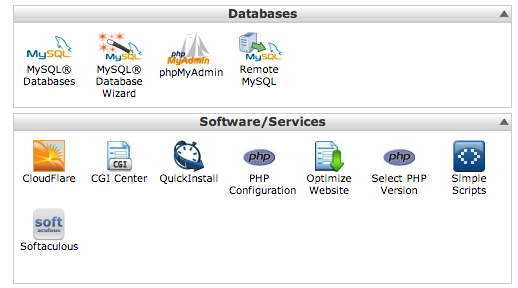
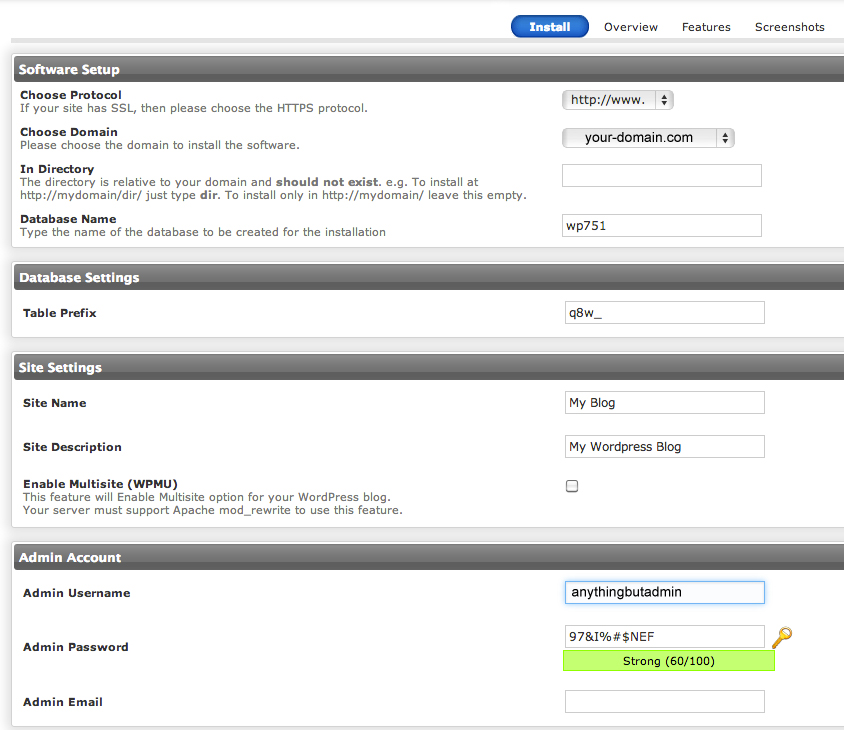
Installing WordPress
What Is Needed For a Manual Install
- Access to your hosting control panel to create a database and database user
- A SFTP Program. SFTP (or FTP) is the method used to upload and download files between a computer and a hosting account
- A Web browser. Installation is performed step-by-step on a web browser
The Manual Install
A Quick tour
Detailed instructions are found here at http://codex.wordpress.org/Installing_WordPress
Access to your hosting control panel (cPanel) to create a database and database user
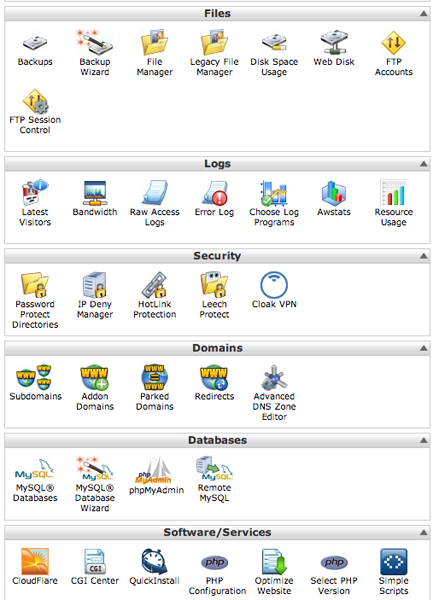
Create a database and database user

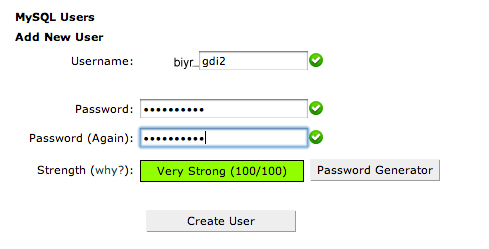
Be sure to check all of these boxes:
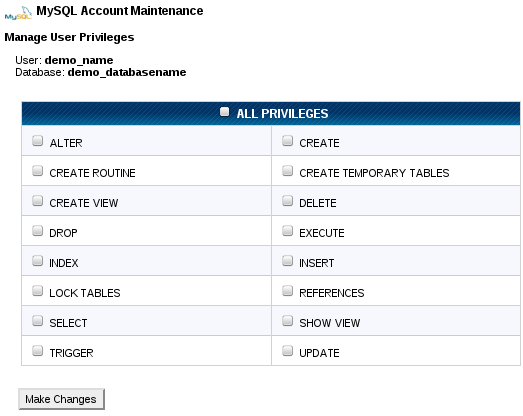
Download the latest WordPress version from wordpress.org

The files

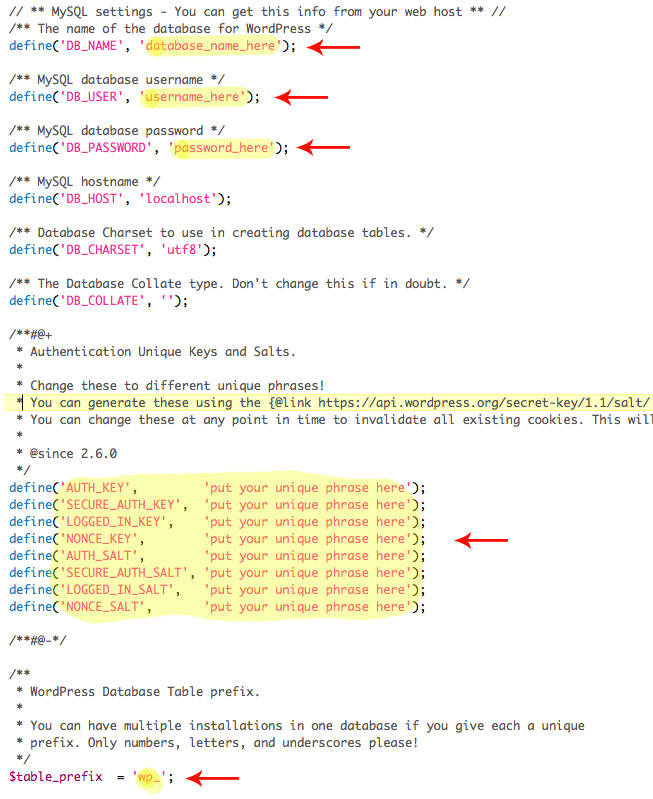
Upload the WordPress files to the desired directory using an FTP (File Transfer Protocol) Program. FTP (or SFTP) is the method used to upload and download files between a computer and a hosting account
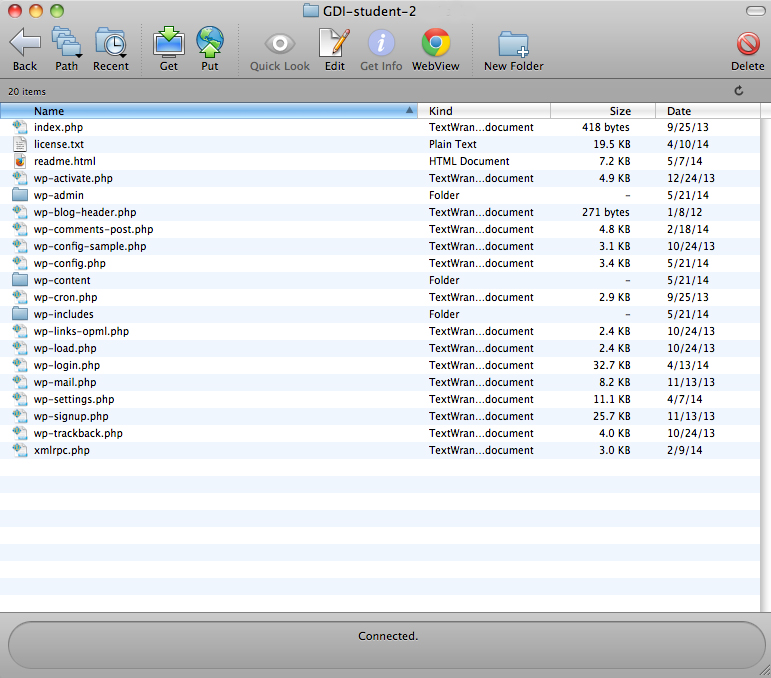
Installation is performed on your web browser by going to the URL where you uploaded the files.
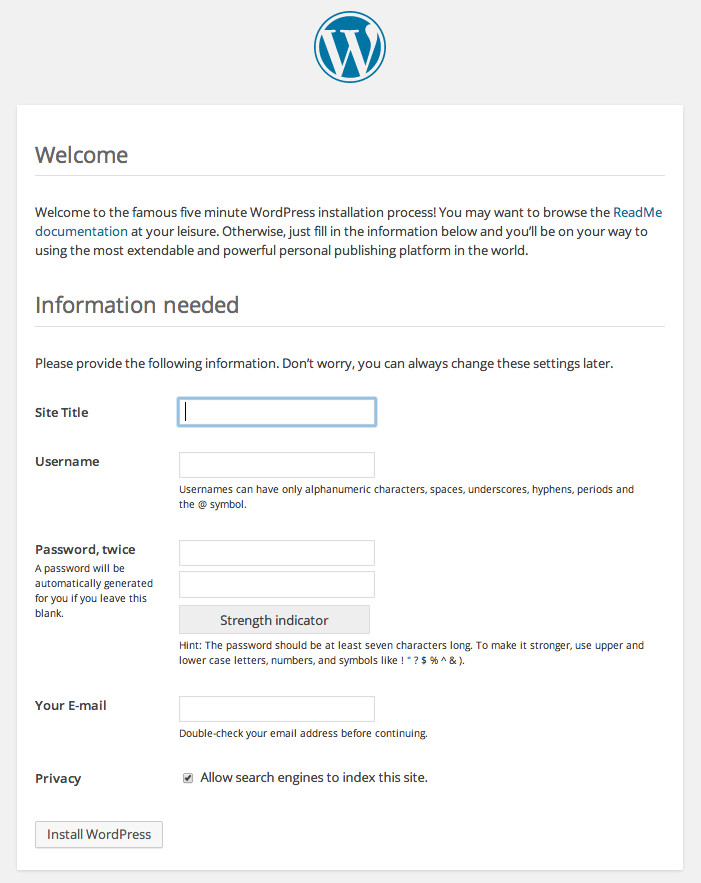
WordPress Workflow
Developing locally
Resources
Changing the URL of WordPress
When you have finished developing your site locally and are ready to move your site to the desired URL, you will
want to read the following pages:
Moving WordPress
There is a lot of information about this. Here are a couple more good resources:
Migrating a WordPress Site From a Local Server to ProductionMigrating WordPress Across Hosts, Servers and URLs
Resources
Changing the URL of WordPress
Another option for moving your WordPress site to another domain or host is to use the Backup Buddy plugin. This plugin is not free. You can also use it to easily backup and restore a WordPress site.
Resources
Attend a WordCamp
WordCamps are affordable, informal, community-organized WordPress conferences held all over the world. They are packed with workshops geared toward WordPress users, designers and developers.
Resources
- wpbeginner: lots of great info for WordPress beginners!
- Join the San Francisco WordPress Group: meetup.com/wordpress-sf/
Questions?
One-on-one help time
Feel free to pull me or a TA over to answer questions specific to your projects or regarding any issue not covered in class.